R.M.S.
Carmainia of 1905 to 1932
Please Note: Firefox and some other Search Engines may not be suitable
Use Google Chrome for this Web Page to load perfectly!
Please Note: All ssMaritime and other related maritime
sites are 100% non-commercial and privately owned, thus ssmaritime is NOT
associated with any shipping company or any other organisation! Although the
author has worked and been involved in the passenger shipping industry for well
over 60 years, but due to his old age and poor health, he was forced to retire.
Yet, he has completed well over 1,550 Classic Liners, Passenger-Cargo Liners as
well as humble converted C3 converted Migrant Liners, which has transported
countless thousands folk to the new world, as well on vacations’. I trust
the features online will continue to provide Classic Liner and Ship enthusiasts
both the information they are seeking, but more so provide a great deal of
pleasure and relive many happy memories!
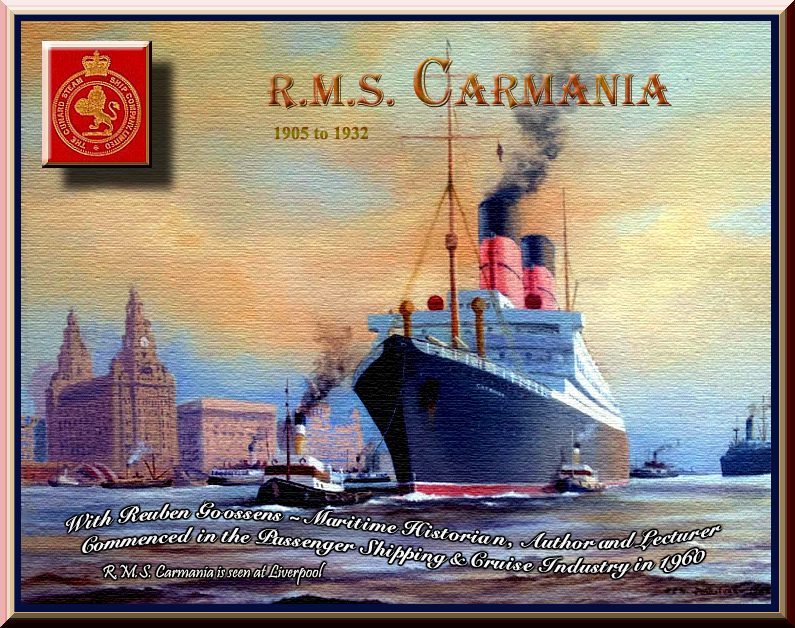
Please Note: Postcards, photographs & other images are either from the author’s private collection.
A special thank to the three ssmaritime supporters for sending their most welcome Photos & images
Ronny MacQuoid (
I am sorry but some of the images shown are not of the highest quality, but they are the best that were available
Introduction:
The 19,566 GRT (Gross Registered Ton) “Carmania” (completed November 1905) was the sister ship of the 19,594 GRT “Caronia” (completed February 1905), yet they actually ended up having completely different machinery installed, in addition the “Carmania” was a triple screw liner, and the “Caronia” a twin screw liner. The R.M.S. Carmania was powered by the then innovative Parson’s steam turbine engines, which offered higher speeds, simpler maintenance and best of all, lower operational costs. Thus she was effectively the test ship for operating a turbine engine on a large passenger liner, whilst her sister, the R.M.S. Caronia was operated by the more traditional quadruple-expansion steam engines. These very different systems were installed purposely as it was done to test the effectiveness of these two systems, and which would be the most effective for the future. Another feature that differentiated the two sister ships was that “Carmania” had two tall forward deck ventilator cowls, which the “Caronia” did not have. But there was something else about these two fine sister ships, for at the time they where the largest and fastest liners in the Cunard fleet.

Carmania’s earlier sister the R.M.S. Caronia
Design, Construction and
Launching:
The “Carmania”
was designed by
The order was placed for her to be built by
“John Brown & Company” at
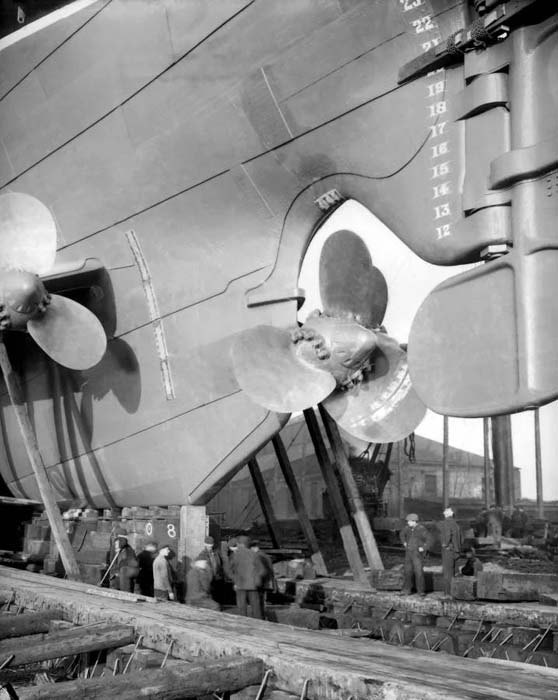
Her stern and triple screws and rudder are seen at the John Brown Yard 366
Thank you David Smeeton for your kind assistance
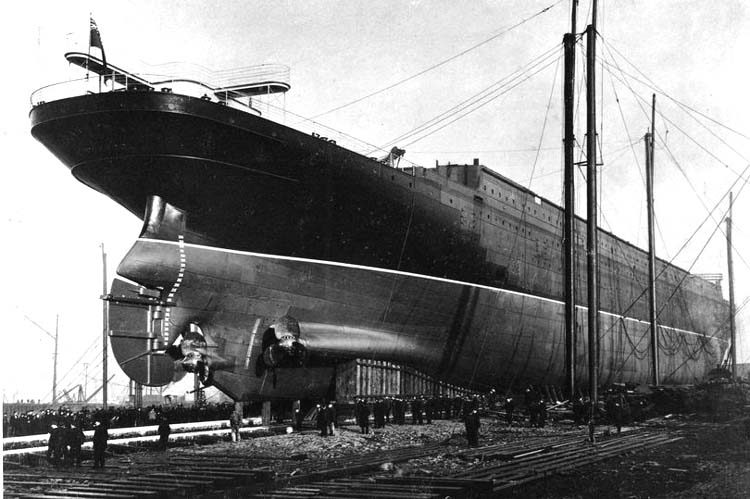
Here we see another view of her stern and her hull prior to her being launched
On February 21, 1905 the hull of the “Carmania” was launched by Lady Blythswood,
who was the wife of a former aide to Queen

She is seen having
been launched and is being towed to the
It became known that the R.M.S. Carmania was in fact the forerunner of the 31,550 GRT steam
turbine liner the “
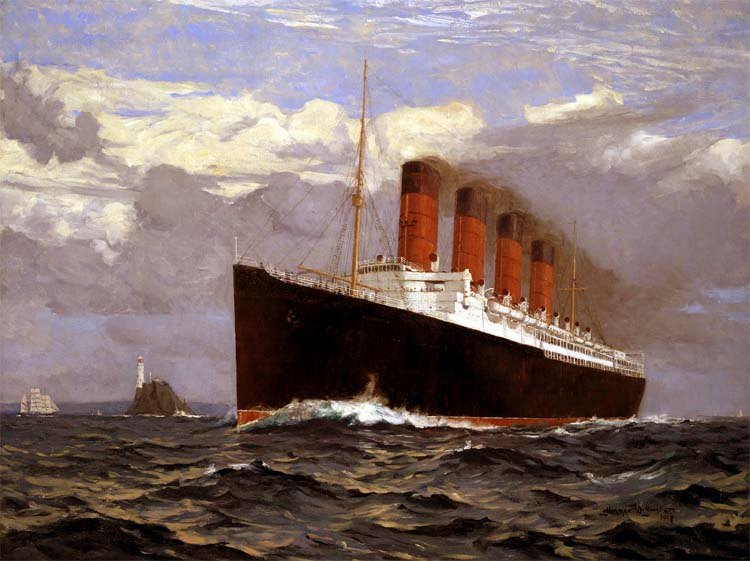
A pre-launch artistic postcard of the R.M.S. Lusitania
When the “Carmania” was completed at the “John Brown”
fit-out berth she undertook her deep sea trials in the third week of November
1905 and during her speed trial just
off Skelmorlie she achieved an excellent
20.19 knots or 37.39 km/h, thus her trial was a huge success! The “Carmania”
was delivered to Cunard Line at
The R.M.S. Carmania accommodated a total of 2,650 passengers, with 300 in First Class, 350 Second Class, 1,000 Third Class and 1,000 in Steerage. Her holds included 46,280 cubic feet (1,311 m3) of refrigerated cargo space.
Her Maiden Voyage and
Service:
In
R.M.S. Carmania with
passengers having boarded on December 2, 1905 departed for her maiden voyage
sailing from Liverpool to
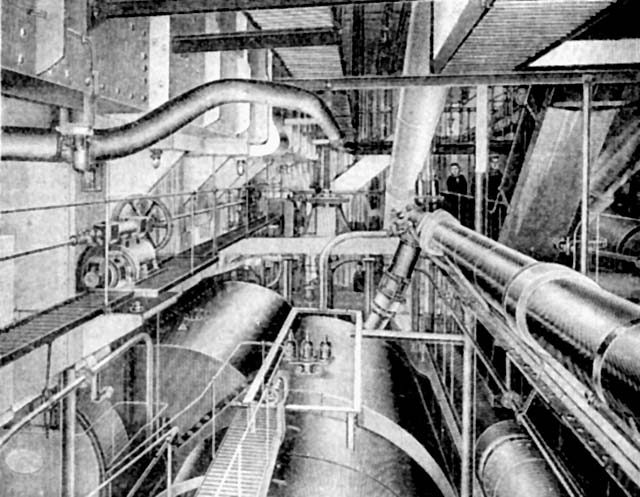
An artistic view of her engine room
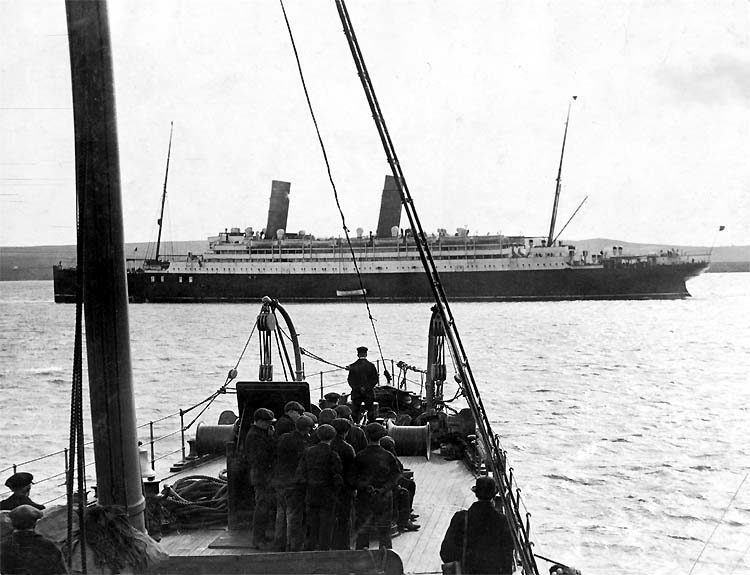
Thank you
Interiors:
First Class:
Boat Deck offered “Carmania’s” magnificent ‘Lounge’ and it was a delightful venue, where smoking was permitted even when ladies were present. There was a buffet where tea and coffee and light refreshments would be served. The venue was furnished with sofas along the walls, and large comfortable lounge chairs with high backs with comfy head rests, as well as timber and partially upholstered chairs. The occasional tables were round and made of walnut. The overall colour scheme was blue, with scattered red Persian rugs, with beautiful mahogany timbers featuring along the walls and shapely carved columns throughout the room and above an elegant ceiling with a glass well that featured stained glass panels.
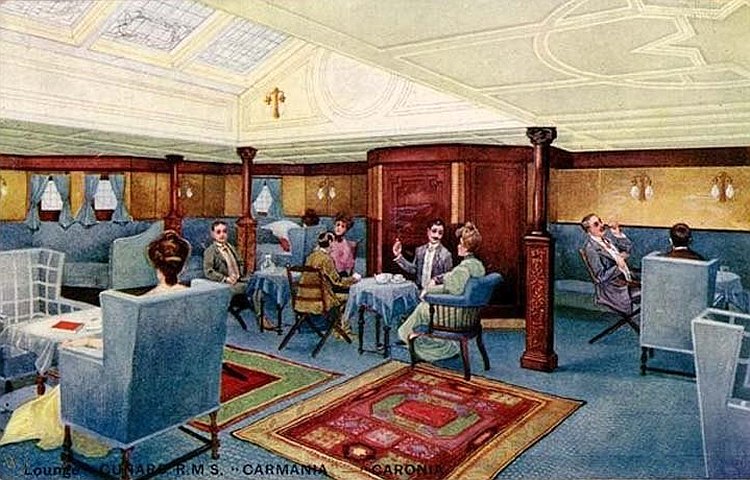
Above & below: A colour postcard of the Lounge and an actual photograph of the venue
Thank you Ronny MacQuoid for your kind assistance and the photo below
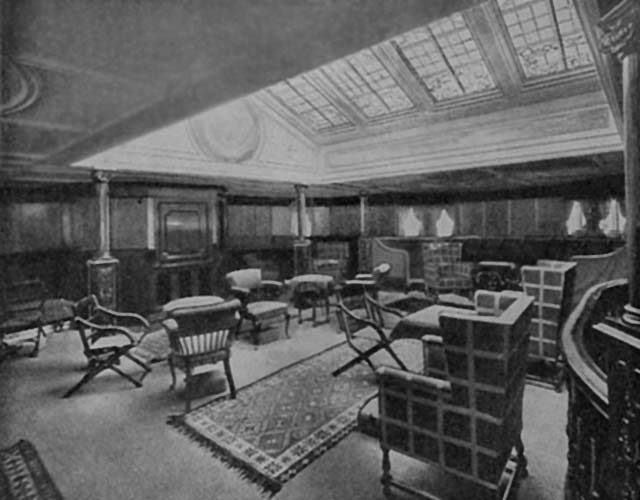
One deck down we find Upper Promenade Deck and here was the delightful ‘Writing Room’, that was a most tasteful room, with a ceiling and bulk-heading treated in the delicate Adams Style, all painted and finished in an ivory white, with rich and luxurious furnishings in a restful shade of green.
Passing through archways we arrive in the elegant ‘Drawing and Music Room’ and this venue also features the Adams Style with the bulk-heading being exquisitely panelled and moulded, broken by pilasters richly carved and fluted. The ceiling and bulk-heading was in ivory white with rose silk panels.
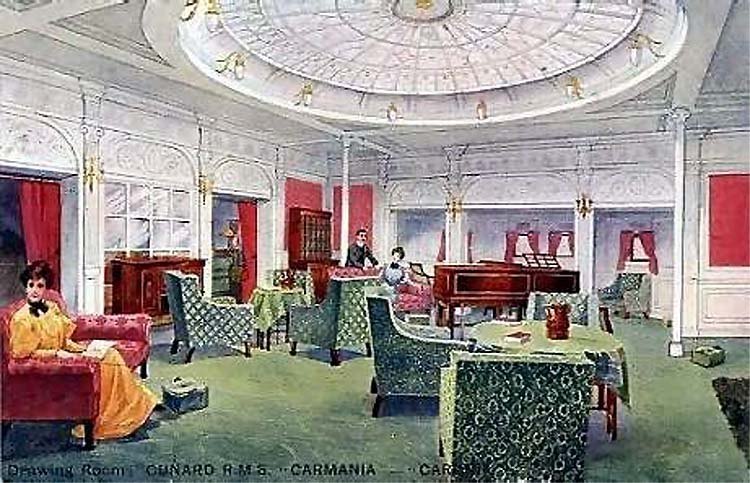
Above & below: Again two views of the Music & Drawing Room in colour and a black and white photograph
Thank you Ronny MacQuoid for your kind assistance and the photo below
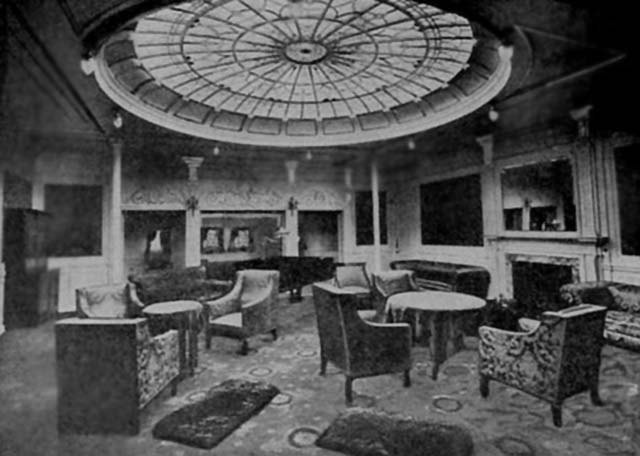
Carpets and furnishings were in a shade of green, and tables and cabinets, etc were all in a dark mahogany. The lounge chairs were upholstered in velvet in a delicate rose and green. A fine feature was the mantelpiece with hammered brass sides and a canopy. The room was flooded with a soft light from the beautiful circular dome above, with its beautiful leaded glass panels certainly added to this fine room.
Next was the ‘Smoking Room’, being located aft on this deck. Its style was mostly Elizabethan, and it was a most pleasing and comfortable room. The panelling was in oak and was enriched with carved pilasters and those fine pillars. The floor was laid with parquet, and the ceiling was panelled in a deep cream with oak moulded beams. In the ceiling there was another glass dome in the center of the room.
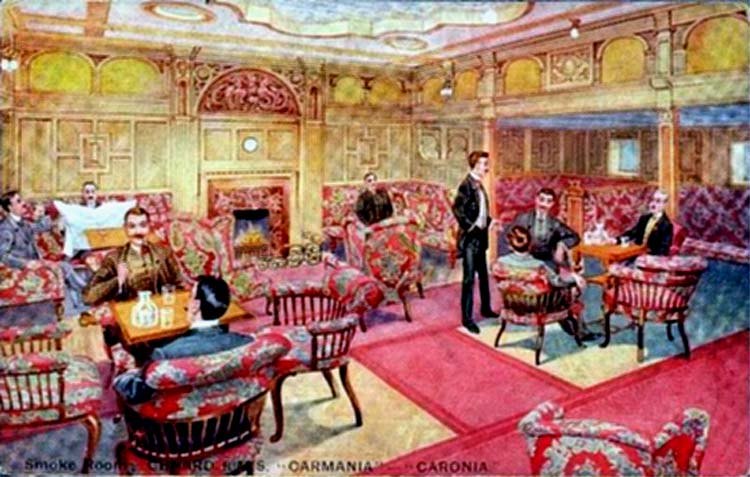
Above & below: Two views of the Smoking Room
Thank you Ronny MacQuoid for your kind assistance and the photo below
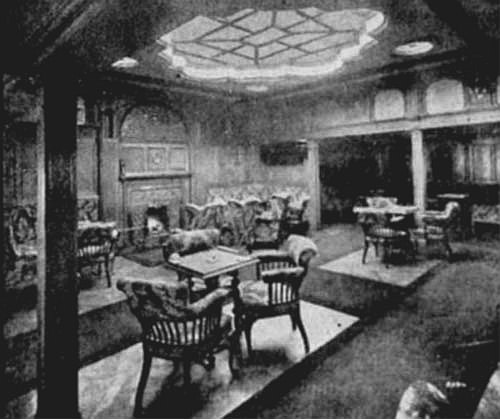
The Smoking Room was more like a very comfortable lounge in a large country house, and obviously was a very popular venue onboard.
Two decks down was the ‘Dining Saloon’, and it was located amidships, and the venue stretched the full width of the ship, and seated 300 guests. This time the style employed was Georgian, and in the centre of the room a large octagonal dome was arranged with the sides opening out onto the alleyways on the deck above. The sides, pillars, and ceilings of this dome was decorated in Ivory white and enriched with gold that formed a most pleasant sight.
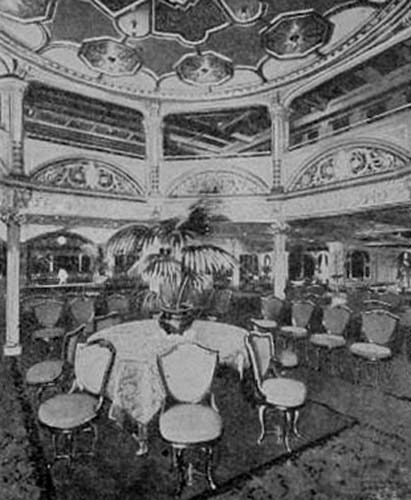
The Dining Saloon
Thank you Ronny MacQuoid for your kind assistance
Instead of long lines of tables, as had been the custom, on the “Carmania” they were more scattered and the tables were from seating four, six eight to the largest being twelve. Also the chairs instead of being the usual revolving ones, the chairs were very comfortable and had shield backs.
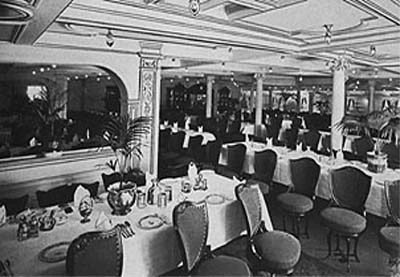
A view of the Dining Saloon nearer to the side of the ship, and a good view of the chairs
Accommodations:
First Class offered accommodations for one, two or three passengers. There were a good number of staterooms with an en-suite having a bathroom, whilst there were also the deluxe suites which had a bed room, a lounge, the bathroom with a separate toilet room. The en-suite rooms were spacious and featured ivory white panelling, velvet, pile carpets, luxurious settees and armchairs, dressing tables, wardrobes, writing tables, bookcases and there was hot and cold water available. The bedding were wide berths. Curtains in all staterooms were of the finest damask and the carpets were in a rich red giving these accommodations a comfortable and a cheerful rich appearance. The rooms were well lighted and an electric bell was fitted at every bed or berth to have your steward come to your room.
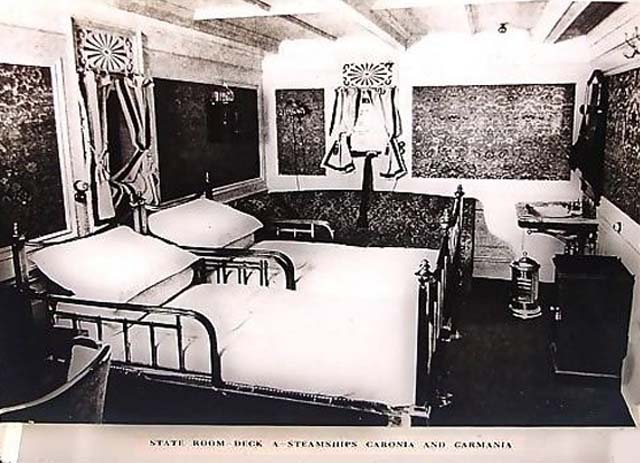
A stateroom with a bathroom on A Deck
Second Class:
Her Second Class Public Rooms as well as her staterooms were a vast improvement to all the ships of the past, as they were well presented and of a much higher quality.
On B Deck aft, which was also another covered promenade deck, we find the Smoke Room and the Drawing room.
The Smoke Room was fitted out in Mahogany panelling, with its seats covered in blue ‘moquette’ arranged in bays around the room, the venue also had deep easy chairs, armchairs and tables, whilst the floor had carpet runners. The room was appealing, comfortable and luxurious.
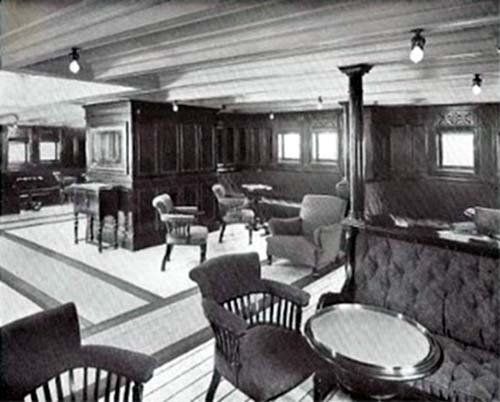
The Smoking Room
The Drawing Room was beautifully panelled in satinwood and featured carved pilasters. This venue also contained the Library which had an ample selection of books located in a fine timber cabinet, and also it had a writing space with special tables and chairs especially arranged.
The Dining Saloon was panelled and finished in ivory white, with soft blue coverings to the seats and blue carpets. There was an attractive sideboard fitted at the forward end, and aft there was the piano. The chairs were revolving type and the general effect was most pleasing. This room also extended the full width of the ship, ensuring ample light and ventilation from its large square ports.
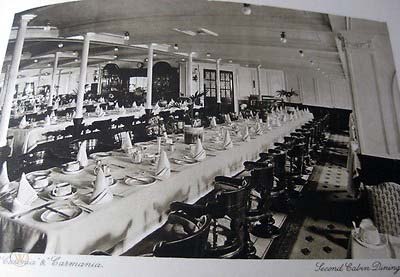
Their Dining Saloon
The staterooms were generally based on a two or four berth configuration, but their interior fittings were similar to those of the First Class staterooms; the rooms were notable by reason of their size, and were with wide spring berths, comfortable sofas, they had an unusual feature, being a fold-up toilet to save space. There was a wardrobe berth curtain, the same carpets and curtains as in First Class, thus Second Class was really excellent for their time.
Third Class:
Third Class was broken up in two parts with up to a 1,000 in each section, with the lower section “Steerage” and its passengers were housed in large ‘male’ or ‘female’ dormitories’, which was used only by immigrants.
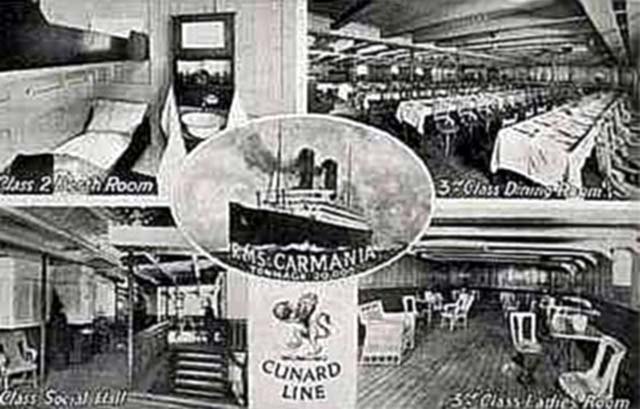
A postcard with a few views of Third Class venues
Third Class had a very large Dining Room located amidships seating 500 at a time, and it was panelled with American Ash and teak dado. The tables were fitted with revolving fitted chairs, and there was a sideboard as well as a piano for entertainment. There was a Smoke Room as well as a Ladies Room both with comfortable lounge chairs and tables, as well as ample deck space.
Accommodations offered cabins for two, four six berths, all with wardrobes and washstands. Ample public facilities were provided and they were maintained to Cunard’s famous highest standards! Steerage was accommodated mostly in large dormitories.
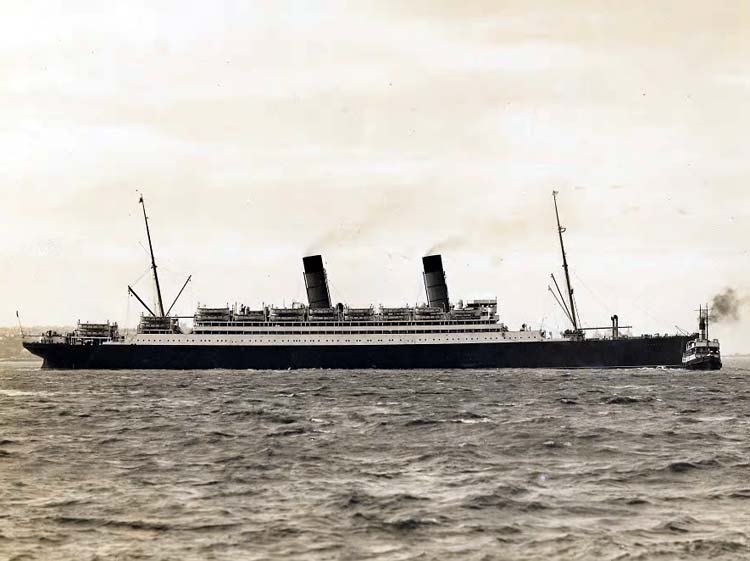
Fire at Liverpool :
Whilst the “Carmania” was berthed at Liverpool on June 2, 1912 she was almost lost to fire, however thankfully the fire did not reach her major passenger decks nor the engine room after repairs were completed on October 4 she returned to her regular duties. The fire was even reported in “The New York Times” on June 3, which stated;
“
I am not sure how correct the description was, but it proves the date, for I noted that most historians have this fire occurring “in June 1910” which is completely incorrect, there is even a photograph of the fire with a date on it and that, besides “The New York Times” proves that it was indeed June 2, 1912.
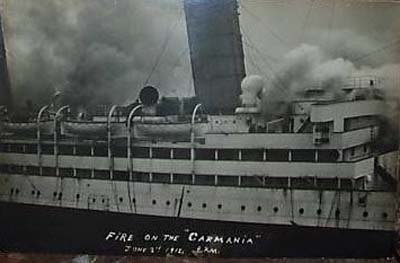
At the bottom it states - “Fire on the Carmania June 2nd 1912, 8pm”
Thank you
For interest, on January I, 1913 “Carmania’s” Captain, James Clayton Barr was officially promoted as Cunard’s Commodore, as the previous Commodore Captain, R.C. Warr had just retired after a long time and given the company excellent service!
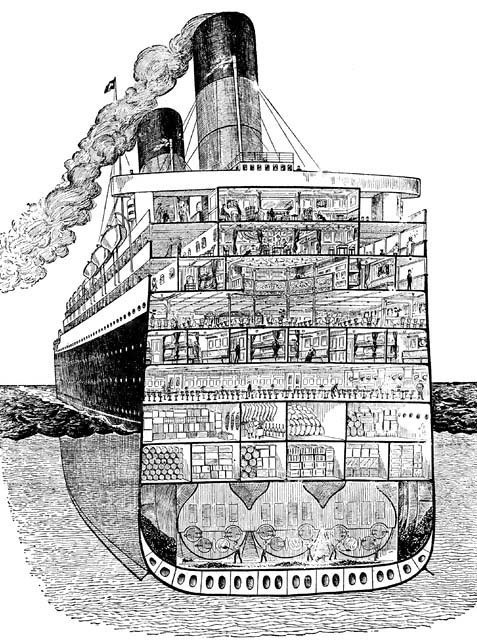
A promotional cut-away image of the “Carmania”
Thank you Ronny MacQuoid for your kind assistance
But there was to be a major event on the
horizon whilst she was on a voyage from
The S.S. Volturno Story:
At this time the 3,602 GRT “Volturno” was owned by the Canadian “Royal
Line” but in October 1913 she was under charter to the “Uranium
Steam Ship Co Ltd”, for a
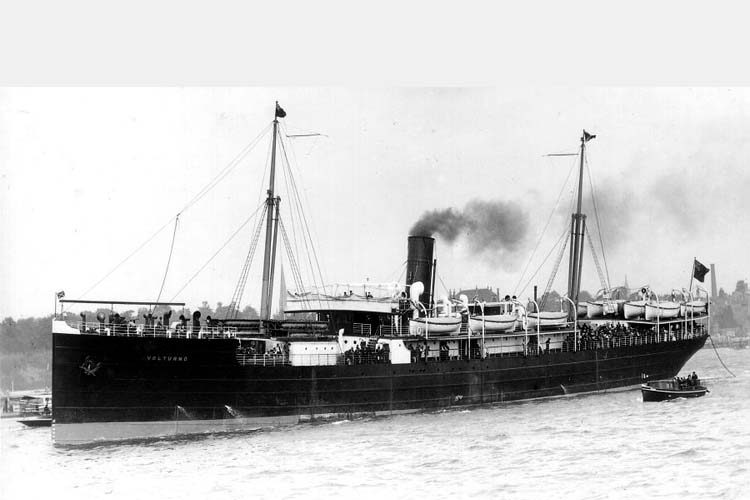
The small
passenger cargo ship -
During her tragic voyage, apart from a very
small number of first class passengers the rest of her passengers were
immigrants in third class bound for a new life in a new country, but sadly this
would not be for many. Apparently her forward hold was filled with a cargo that
contained highly flammable chemicals. And on October 9, 1913 around 0600 hours
the ship suddenly caught fire during a wild storm on the

The “Volturno” is seen on fire and listing to starboard
The fire soon spread to the ship’s coal bunkers and it cut power to the ships fire pumps. The crew fought the fire for around two hours but, realising the severity of the fire and the limited options for dousing it, her Captain, Francis Inch radioed an S.O.S. and thankfully a total of eleven ships responded to her reported position, arriving throughout the day and one the next day. In the meanwhile, several lifeboats with women and children aboard were launched; but sadly all either capsized or were smashed against the ship’s hull, leaving no one alive from the boats that were launched.
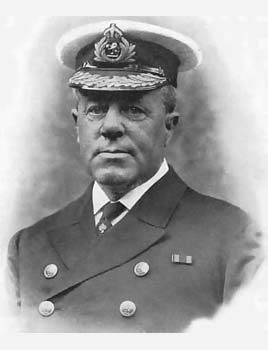
Commodore
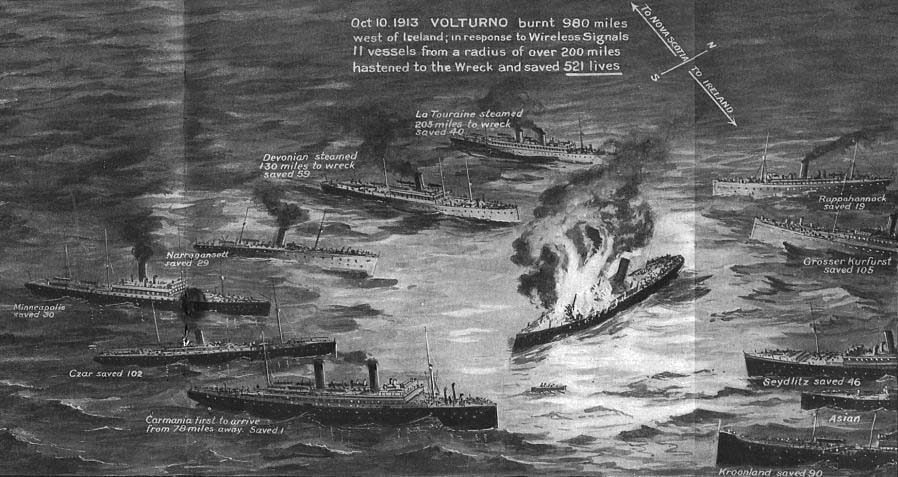
The “Carmania” and nine other ships are seen surrounding
the Volturno with
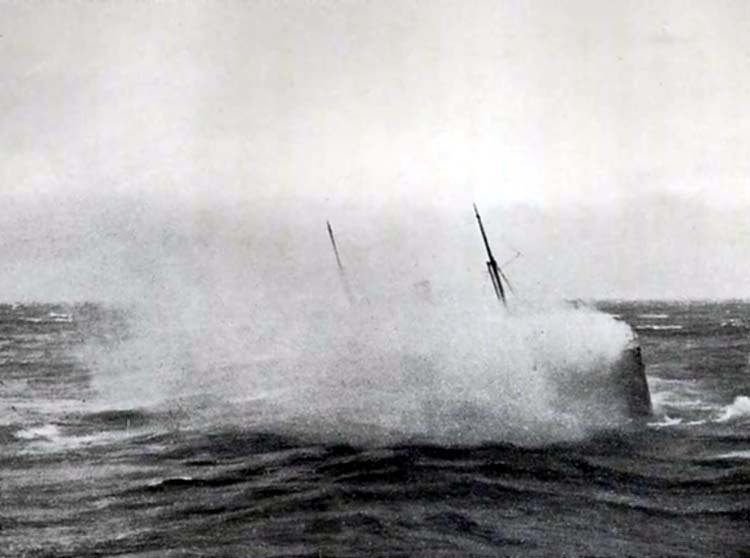
A photo taken from
the decks of the
The “Carmania” picked up as many survivors as was possible from the fire damaged ship during the storm, but the sad fact was that 30 of the crew and 130 “Volturno” passengers tragically lost their lives. The rescue resulted in many awards for gallantry being presented to members of “Carmania’s” crew especially Commodore Barr.
World War One:
On August 8, 1914, after the outbreak
of World War I, the “Carmania” was
requisitioned by the Royal Navy and she was sent to the Sandon
Dock,
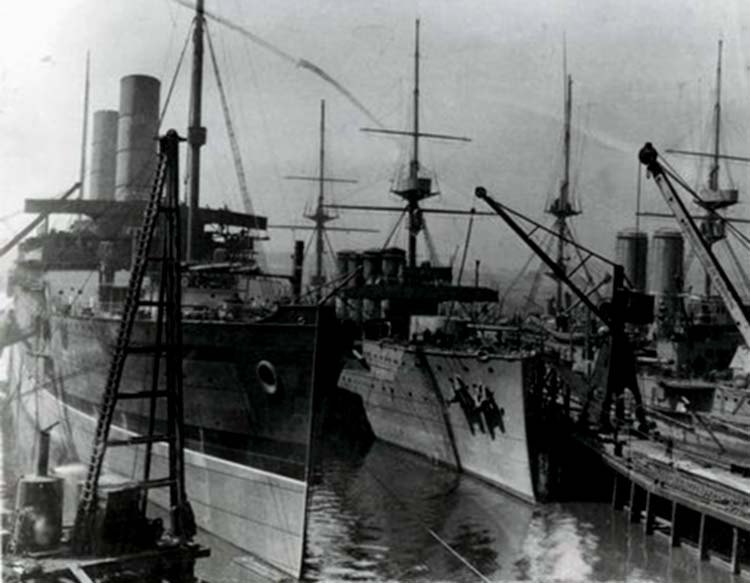
The “Carmania” is seen on the left being refitted as an “Armed Merchant Cruiser”
Thank you
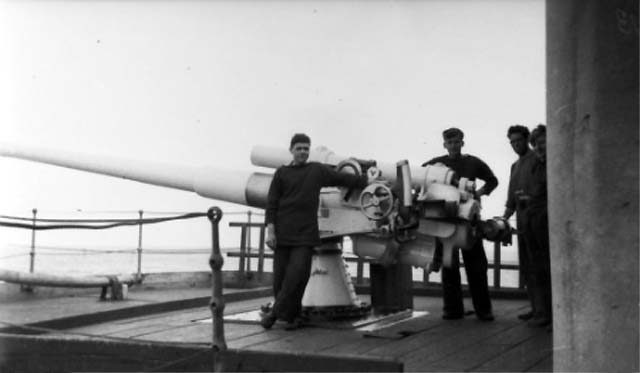
Here we see one of the 8 “QF 4.7 in Mk V naval guns
She was manned for her war duties as follows;
the Captain, 24 Officers, 43 Petty Officers, 131, Seamen, 38 Marines, 156
Engine-room crew and 28 Stewards, a total of 421 personnel. Having been officially
commissioned she was now the H.M.S. Carmania,
with the pennant number M 55. The “Carmania”
had been placed under the command of Captain Noel Grant RN, and when ready she
departed Liverpool and headed for
The Battle
Introduction:
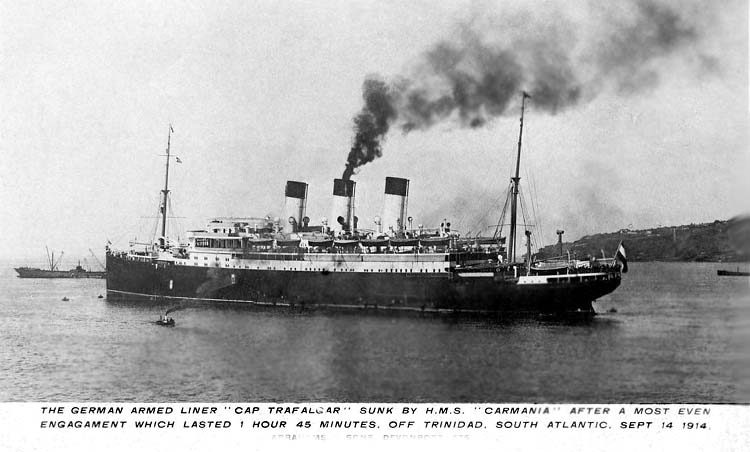
S.M.S. Cap Trafalgar seen before the removal of her dummy aft funnel
Thank you Ronny MacQuoid for your kind assistance
The German Imperial Navy requisitioned the
three funnelled S.M.S. Cap Trafalger to become an
Auxiliary Cruiser, although her aft funnel was a dummy stack. After they
installed guns on her, they decided to remove the aft funnel in order to change
her appearance. Amazingly as a two funnelled ship, the “Cap Trafalger” looked very much like the
She was armed with two 4.1 inch guns and six one-pounder pom-poms, and they were manned by experienced naval personnel, and she was given the mission to sink as many British merchant ships as possible. She was given the codename “Hilfskreuzer B” (Auxiliary Cruiser B) and her commander was Korvettenkapitän Wirth.
The Cap Trafalger set
off on a voyage in search of British merchant vessels so that she could sink
them, but failed to locate any and in early September she returned to
her rendezvous point off
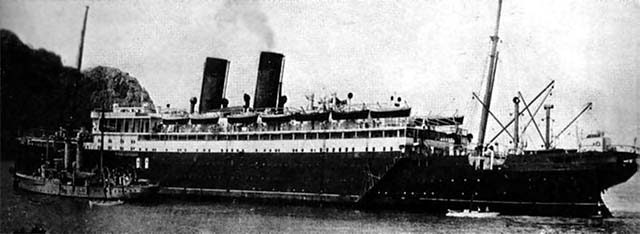
The S.M.S. Cap
Trafalgar is seen with her 3rd funnel removed, and the small
September
14, 1914,
The battle that was about to take place has become known as the “Battle of the Doppelgänger”, because the “Cap Trafalgar” looked so much like the “Carmania”.
The
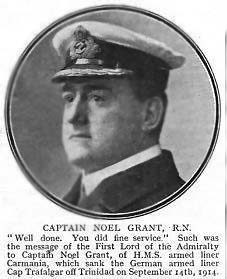
Around noon the “Carmania” could see the other ship clearly, but the “Cap Trafalgar” turned about and steamed away from the “Carmania”. At first H.M.S. Carmania’s captain may have been confused for her two funnelled prey was painted almost identical to her. There was no reason for a fellow British ship to flee, thus he was suspicious and he decided to pursue. After a short chase, “Cap Trafalgar” suddenly turned to starboard and began bearing down on the “Carmania”.
Then at 8,500 yards, the “Carmania” fired the first shot. A shell whizzed towards the German ship, splashing in the ocean nearby. The “Cap Trafalgar” responded almost immediately with her starboard main gun, and a 56-pound piece of steel flew out at 2,300 feet/second.
A plume of water shot up next to the “Carmania”. Both ships then opened fire. However the “Carmania” was able to bring 4 cannons to bear, while the “Cap Trafalgar” had just 1 cannon and 3 auto-cannons. It was her auto-cannons, being essentially heavy machine guns, which proved the most effective. They hit the “Carmania’s” upper decks fore and aft, sending shrapnel, marble, and splinters flying down the corridors of the luxury liner.
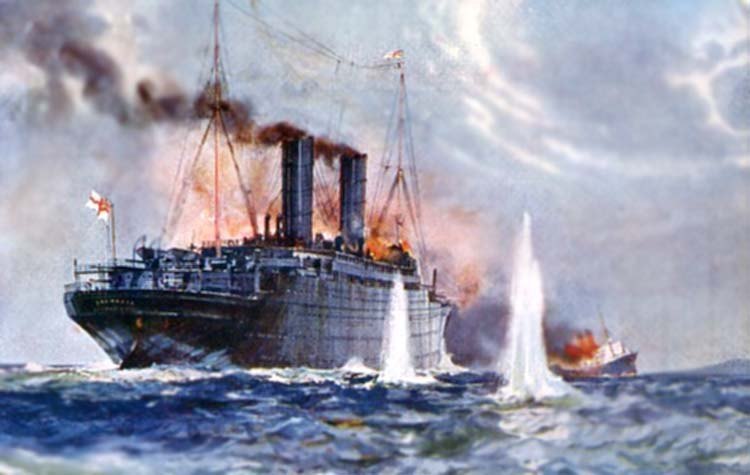
The
But then H.M.S. Carmania scored a hit on “Cap Trafalgar’s” bow, starting a fire and causing her to list to starboard. But next “Carmania’s” forward cabin, just beneath the main bridge, caught fire as well as a shell destroyed her fire mains, thus they were now unable to extinguish the rapidly growing fire. The bridge was abandoned, and the Captain and his officers moved aft, fleeing the massive flames
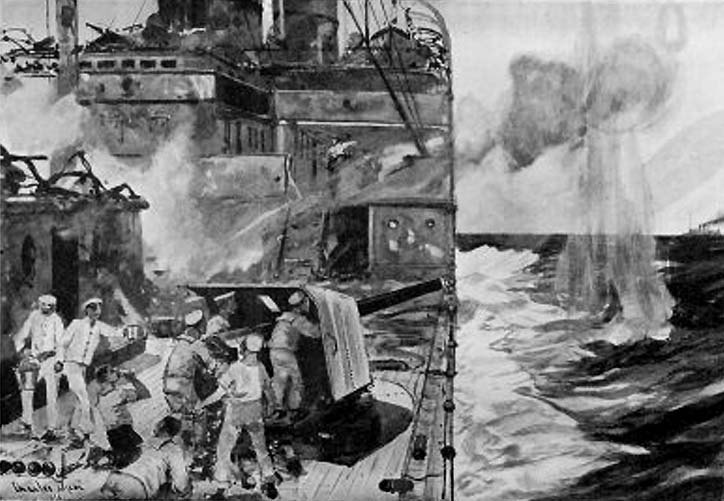
A drawing of the
gun battle as seen on the
Thank you Ronny MacQuoid for your kind assistance
Both ships continued the battle, their once
majestic interiors filled with many wounded crew, and the ships filled with
smoke, and debris. The “Cap Trafalgar” continued to fire onto
“Carmania’s” decks, hoping to
destroy her guns. Then the “Carmania”
altered her aim and targeted the “Cap Trafalgar’s” water line
and they blasted a hole after hole in the ship’s side. As the battle
progressed, the “Cap Trafalgar” began to take on water and she
began to list heavily. Her crew continued firing their machine guns, making
sure they defended the pride of their captain, their ship, and
Finally “Cap Trafalgar” swung to starboard and started to sink, and her crew rushed onto her lifeboats, whilst others jumped into the debris-filled ocean. Some were trapped inside the ship and had no chance to escape. With the “Carmania” being barely afloat she was listing badly as fires continued to burn, with all the communication and navigation equipment on the bridge being mostly destroyed. She turned away and headed south, hoping to rendezvous with a British cruiser in the region. By the time she was rescued on the 15th, she was hardly seaworthy and most likely would have sunk if she would have had to remain at sea for a number of days more.
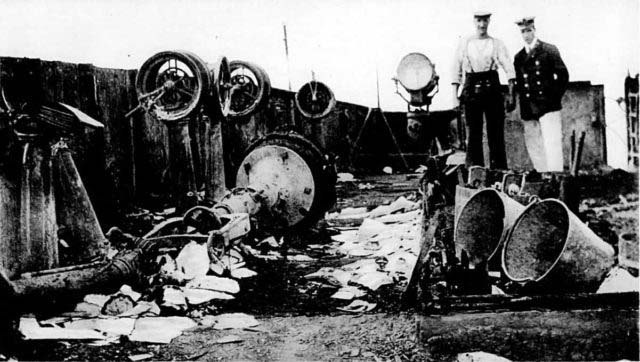
Her badly destroyed Bridge is seen after the event and it really looked to be in a bad state
Thank you Ronny MacQuoid for your kind assistance

A temporary bridge
built for the voyage to
Thank you Ronny MacQuoid for your kind assistance
Although the battle lasted less than 2 hours, it cost the lives of approximately 60 men as well as one of the finest German ocean liners of the time. Despite the shortness of the battle, it was in a way a considerably light casualty count as it was 60 out of just over 600 men in total, for this had been a massive battle to say the least!
Later in the day on September 14, the captain
was in touch with the nearby Naval vessel “
But the next day, the 15th at 4-30pm they
first met the “
But, remarkably with excellent rapid emergency work done, on the very next day the 17th at 5.30 pm she departed “Abrolhos Rocks” with the H.M.S. Macedonia led leading her to Gibraltar, where they arrived on September 28, 1914 and she moored at the naval dockyard there at 10.00 am. Serious repairs commenced and these were finally completed on November 22, and she departed the next day; November 23, 1914 at 10.25 am to resume her regular AMC duties.
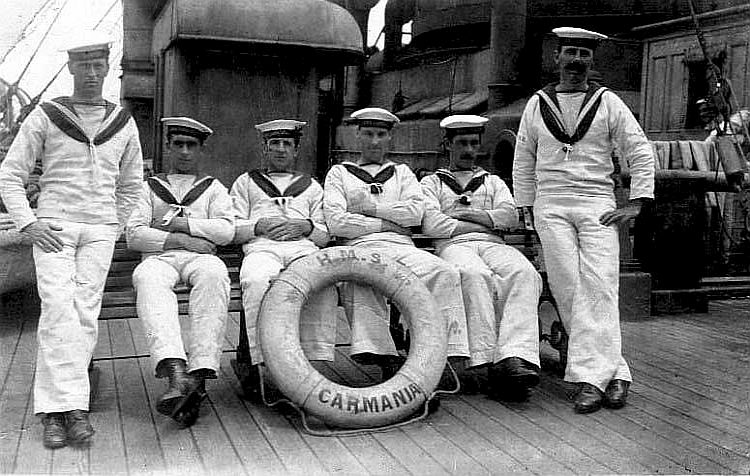
Six fine naval personnel posing for a photograph onboard the “Carmania”
After her repairs in Gibraltar, she
patrolled the coast of
She was finally decommissioned from being an
“Armed Merchant Cruiser” and removal of all naval stores took place
in
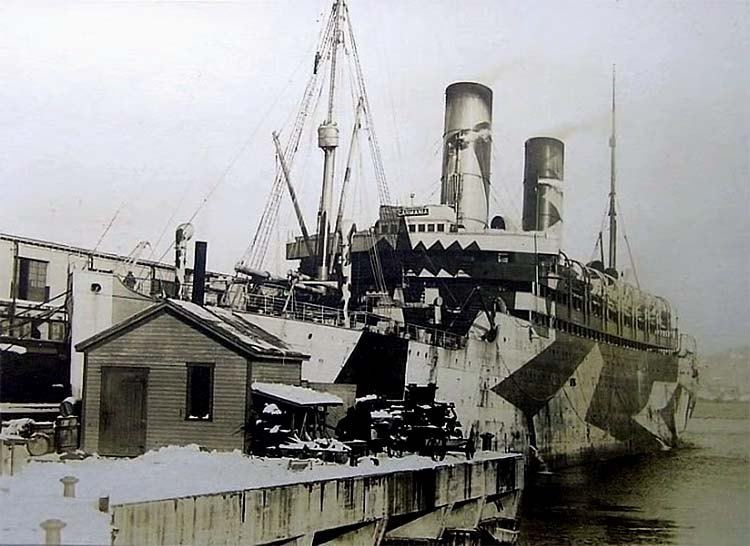
Whilst
transporting Canadian troops home to
After a brief refit she was soon chartered by
the Canadian Government to return Canadian soldiers to their home country. Then
early in 1920, the “Carmania” was given a
major refit and she was made ready to return to her regular Liverpool to
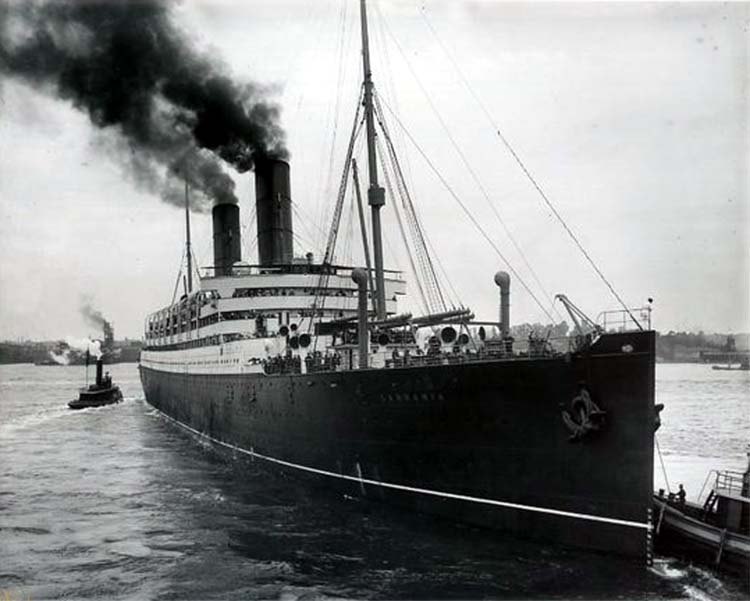
A fine photograph of the “Carmania”
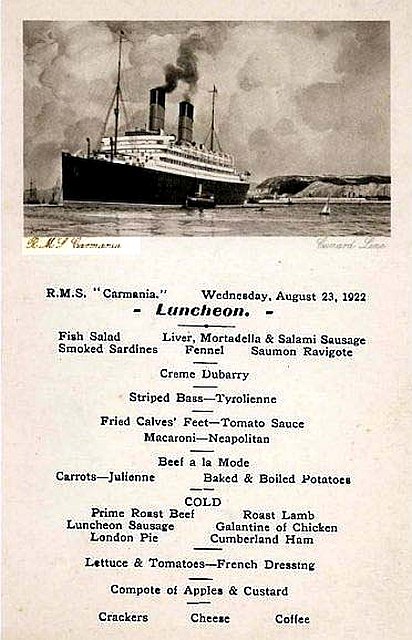
A lunch Menu from August 23, 1922
Then in 1923, Cunard decided to have her refitted to become an one class Cabin Class ship, with accommodation reduced from the previous 2,650 passengers to just 1,440. Her sister the “Caronia” was given similar refit, and the both sisters were kept busy on their Trans-Atlantic service.
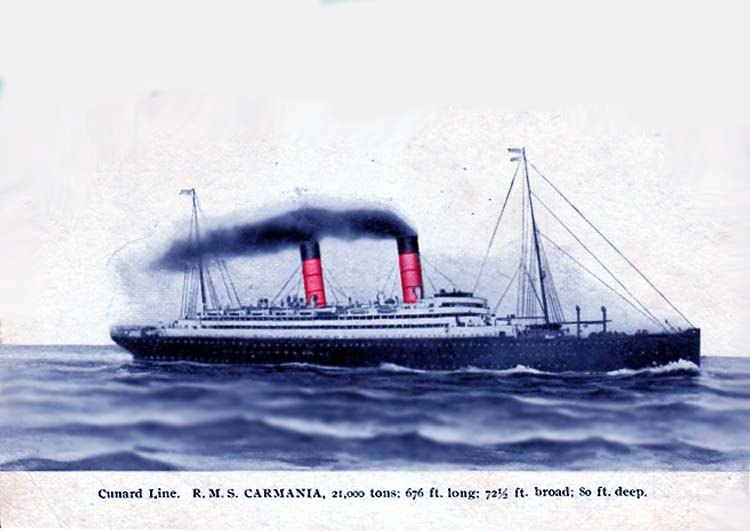
An artistic
postcard of the remarkable
Sadly six years later passenger numbers reduced rapidly due mainly to the 1929 “Great depression” but the Carmania sailed on for she was a very popular ship and a more intimate liner compared to those larger liners operating. Early in 1930 “Carmania’s” navigational equipment was improved to include submarine signalling and wireless direction finding, even though she was closing rapidly to her final days.
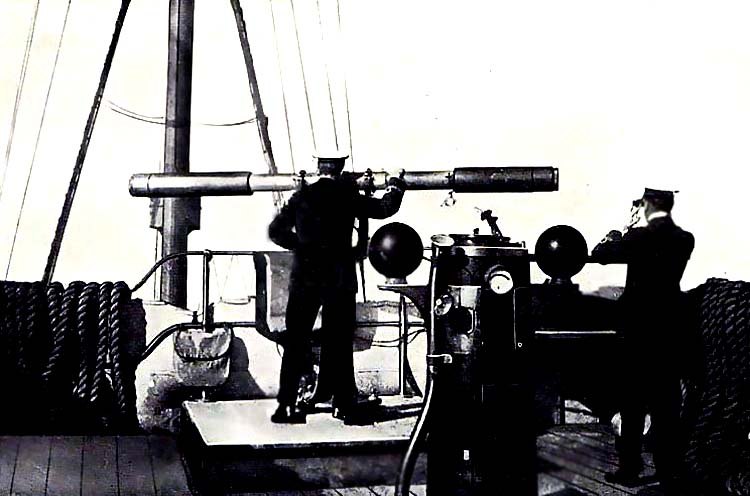
Officers using the Rangefinder
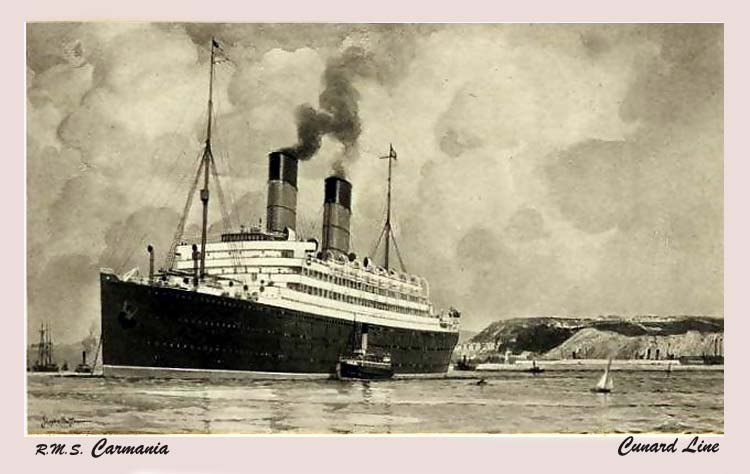
A postcard produced by Cunard
Her Final Days:
Towards the end of 1931 Cunard Line placed
both the “Carmania” and the
“Caronia” on the market and she was
sold in 1932 to the breakers yard of “Hughes Bolckow
& Co”. The once fine liner R.M.S. Carmania
arrived at
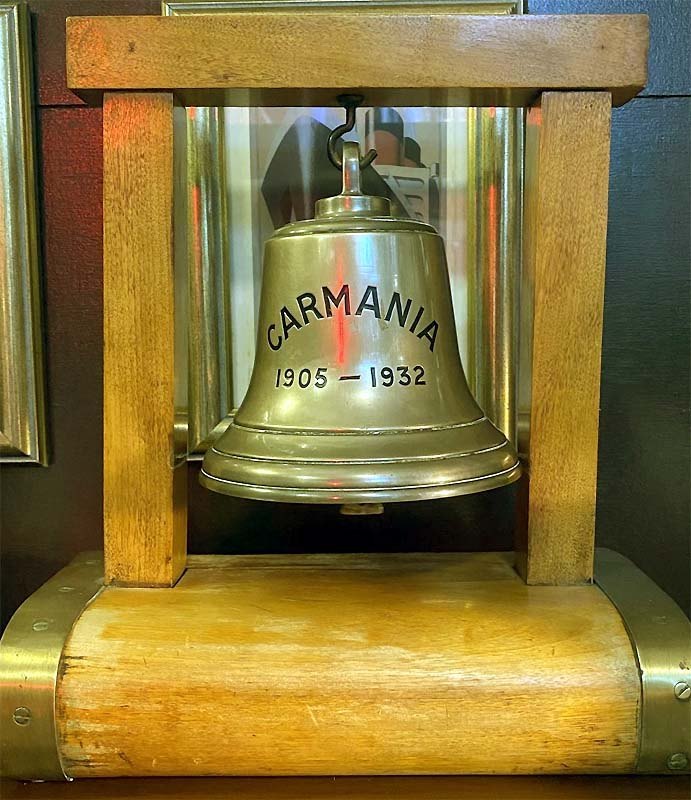
“Carmania’s” bell is on display aboard
the permanently moored HQS Wellington at Victoria
Embankment,
*********************
Specifications and Details:
Ship as built: Carmania.
Type of ship: Passenger - Cargo Ship.
Builder: John Brown &
Company,
Names:
.
Laid Down: May 17, 1904.
Yard; 366.
Launched: February 21, 1905.
Delivered: November 1905.
Maiden Voyage: December 2, 1905.
Official
Call sign: HFBJ.
Owner: Cunard Line.
Launched: March 17, 1931.
Delivered: November 1931.
Operators: Cunard Line. - 1931 to 1949.
. Royal Navy - 1914–19.
WWI identification: Pennant number - M 55 - 1914–16.
AMC Armaments: 8 × QF4-7in Mk V naval guns.
Tonnage: 19,566 GRT, 9,250 NRT.
Length: 650.4 ft - 198.2 m - 678 ft - 207 m o/a.
Beam: 72.2 ft - 22.0 m.
Draught: 33 ft 3 in - 10.13 m.
Installed power: 21,000 SHP.
Propulsion: 1 × high-pressure Parsons steam turbine.
. 2 × low-pressure Parsons steam turbines.
Built by: John Brown..
Propellers: 3 Screws.
Speed: 18 knots - 20.19 knots maximum.
Decks: 8.
Accommodations: Total 2,650 passengers; 300 First, 350 Second, 1,000 Third Class and 1,000 in Steerage..
. 1,440 Cabin Class only - 1923.
Cargo: 46,280 cubic feet (1,311 m3) refrigerated space.
Crew: 450.
Fitted with: Direction finding equipment & submarine signalling equipment.
Sold: April 22, 1932 to “Hughes Bolckow & Co”.
Fate: Scrapped in 1932
at
Remembering the …
R.M.S. Carmania
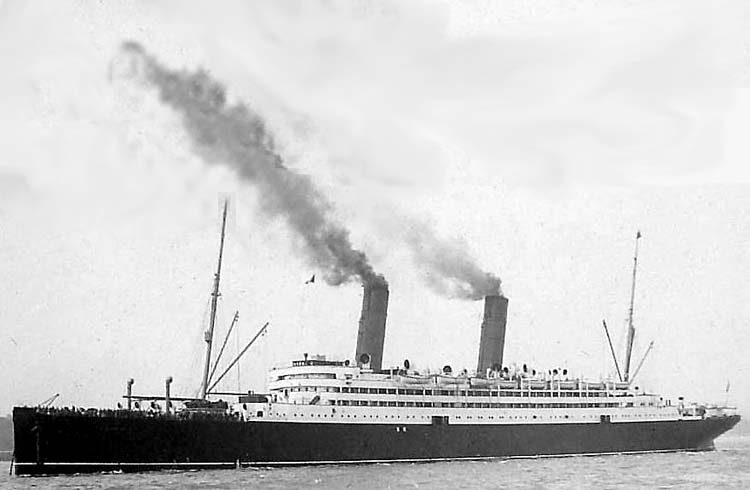
A magnificent view
of the remarkable R.M.S. Carmania arriving on the
**************
“Blue Water Liners sailing
to the distant shores.
I watched them come, I watched
them go and I watched them die.”
Featuring well over 1,500 Classic Passenger Liners, Passenger-Cargo Liners & Classic Cruise Ships!
Or ENTER HERE
For interest: Sadly an email service to ssMaritime is no longer available, due to the author’s old age and chronic illness as well as being disabled, etc. In the past ssMaritime received well over 120 emails per day, but Mr. Goossens can no longer handle same. He sincerely regrets this!
*********************
ssMaritime.com & ssMaritime.net
Where the ships of the past make history & the 1914 built M.S. Doulos Story offline
The Author has been in Passenger Shipping & the Cruise Industry for well over 60 years
In addition he was the founder of “Save the Classic Liners Campaign” in 1990.
Please Note: ssmaritime and associated sites are 100% non-commercial and the
author seeks no funding or favours of any
shape or form, never have and never will!
Photographs on ssmaritime and associate pages are by; the author or from the author’s private collection. In
addition there are some images that have been provided by Shipping Companies
and private photographers or collectors. Credit is given to all contributors.
However, there are some photographs provided to me without details regarding
the photographer/owner concerned.
This notice covers all pages; although, and I have done my best to ensure that all photographs
are duly credited and that this notice is displaced on each page, that is, when
a page is updated!
ssMaritime is owned & © Copyright by Reuben Goossens - All Rights Reserved

